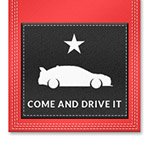

A good alignment will make your car handle, brake, and accelerate better for very little investment. You'll even save money by reducing tire wear with a simple correction to the camber and toe.
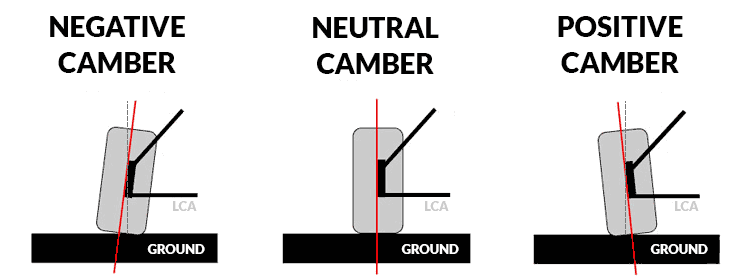
Camber is a measurement of the centerline of your wheel/tire relative to the road surface. It is expressed in degrees and greatly affects the handling dynamics of the car.
Negative camber is when the top of the tire tucks inwards. For a normal car you typically want to maintain a slight amount of negative camber (0.5 - 1°) to have a good balance of cornering grip, braking grip, and tire wear. On most vehicles it's common to have slightly more negative camber (0.8 - 1.3°) in the rear to reduce the chances of oversteer (loss of grip in rear).
Negative camber improves handling by keeping the tire perpendicular to the road as the car rolls; ensuring that the tire's contact patch is evenly loaded. Without adequate negative camber the tire would load the outer portion of the tire and produce less grip.
Adding negative camber will reduce the peak tire grip during straight-line acceleration and braking. It's important to have a healthy balance to ensure good overall performance. For most cars this is around 2 - 3° of negative camber.
Static camber is the amount of camber angle the vehicle has at a rest, and is what gets measured when you get an alignment.
Dynamic camber is the momentary amount of camber angle generated as the vehicle accelerates, brakes, and goes around corners. Dynamic camber is the static camber plus or minus the "camber gain." Camber gain is rarely linear and is a result of suspension design and geometry. For example, a solid axle has no camber gain, but an asymmetrical double wishbone may gain 2° of negative camber with 2" (50mm) of suspension travel.
Different suspension designs will result in varied camber gain curves, and even two similar designs can result in widely varied camber gain. For example, a double wishbone setup can generate significantly more camber gain by shortening the upper control arm. Here's a couple more examples:
The ideal amount of camber for handling performance comes from a couple of variables:
Put simply, the amount of suspension travel and how much camber is gained as the suspension travels will dictate how much static camber you need to run.
As a rough guide, here's a list of camber settings for various suspension layouts and vehicles. This is meant to be a good starting point for a street car setup, but will require adjustment to fit your needs and vehicle specifics.
These settings are meant to be a good starting place for a street car with street radials. Your vehicle may prefer more or less camber.
| Drive Layout | Suspension Type | Camber Angle |
|---|---|---|
| FWD | MacPherson Strut Double Wishbone |
2.0° 1.5° |
| RWD | MacPherson Strut Double Wishbone |
2.5° 2.0° |
| AWD | MacPherson Strut Double Wishbone |
2.5° 2.0° |
| 4WD | MacPherson Strut Double Wishbone |
1.0° 1.0° |
| Drive Layout | Suspension Type | Camber Angle |
|---|---|---|
| FWD | Multilink Trailing Arm Twist Beam |
1.0° 1.0° 1.0° |
| RWD | Multilink Trailing Arm Swing Arm |
1.0° 1.0° 1.3° |
| AWD | Multilink Double Wishbone Trailing Arm |
1.0° 1.0° 1.0° |
| 4WD | Multilink Double Wishbone Trailing Arm |
0.5° 0.5° 0.5° |
Race teams will know how much camber to dial into their car from thermal tire data (tire tread temps), tire wear patterns, previous track experience, and driver feedback. Well-funded teams will have additional data from load cells, shock travel, acceleration sensors, images, and onboard telemetry using thermal cameras.
At proper camber settings the tire will exhibit stable and symmetrical temperatures across the tire surface during cornering. Excessive heating on the inner or outer third of the tire can be indicative of improper camber angle, although not conclusively.
Road conditions can also demand more or less camber. Loose gravel and wet pavement both limit the amount of overall tire grip available, which necessitates less static camber. Banked corners at NASCAR oval tracks require asymmetrical camber setups with positive camber on the LF tire and considerable negative camber on the RF (outer) tire.
Drifting requires a rather unique setup since it pairs the need for good tire life and performance. The front camber will mimic a road race setup at around 3 - 4° to maximize lateral grip ("side bite"). Modified steering geometries (spindles, tie rods, etc.) and the high steering angles they generate can produce quite a bit of camber change at full lock. It's important that the static setup compliments this and any other bump geometry.
The rear should have near zero camber to provide strong forward grip and more importantly, to last quite a bit longer. By using the entire tread face you will evenly distribute pressure along the tire and heat it more uniformly. Both of these things will contribute to a lot more fun-per-tire (reduced tire wear), but at the cost of needing more power than running say 5° of camber and nuking the inner edge.
Positive camber is when the top of the tire extends outward, and the base of the tire tucks inwards. This is rarely ever seen on a road car since it will reduce road handling capability. In special situations, such as NASCAR, positive camber will be applied to handle heavy amounts of track embankment. If you are running a positive camber figure on your street car then its highly recommended that you inspect your suspension for damage and/or adjust the camber to a slight negative figure.
Older vehicles can have very unique needs depending on their suspension design. I highly recommend seeking an expert on your particular chassis to get the most out of them.
Bias ply tires react very differently to camber angle due to the differences in their construction compared to radials. Using the above recommendations, which are meant for radials, can result in lackluster results. Typically, you will run a bias ply tire with considerably less camber. Again, I recommend consulting an expert for further assistance on your vintage setup.
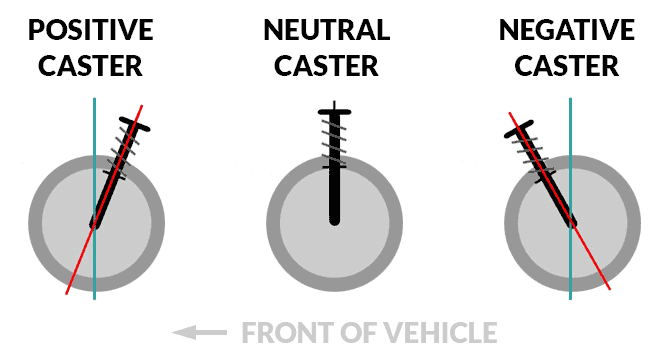
Caster is the measure of how far forward or behind the steering axis is to the verticle axis, viewed from the side. An example of caster in action is the front wheels on a shopping cart. They run a large amount of positive caster to make the cart track straight without wandering. However, the method that the cart uses (displacement caster) is different than how your car develops its caster angle (angled pivot), but the effect is the same.
Positive caster is when the steering axis is in front of the verticle. In a road car, this would mean that the top of the coilover would be pushed towards the rear of the car. Positive caster creates a lot of align torque (the force that straightens the steering wheel when you go forward) which improves straight line stability of the car. Due to the geometry of positive caster it also will increase negative camber gain (a good thing) when turning. As you increase positive caster the steering will get heavier also, but with modern power steering systems this is rarely a problem. Generally you want as much positive caster as you can reasonably get so long as the car is equipped with power steering.
Positive caster angles run between 3 - 5° on modern vehicles. This gives a good mix of highway stability and steering feel. For a more performance oriented setup on a MacPherson strut you can add a degree or two to have more favorable camber gain at high steering angles.
If you are not running power steering, a caster setting of 3 - 4° is a good setup to reduce the weight of the steering and maintain the benefits of positive caster angle.
Negative caster is when the steering axis is behind the vertical. This is generally only found on older vehicles due to tire technology, chassis dynamics, and other reasons. Modern vehicles do not use negative caster. It will lighten the steering effort but also increases the tendency for the car to wander down the road. If you've ever pushed a shopping cart then you've felt the effects of negative caster on the front wheels.
Regardless of what caster setting you use, make sure that your caster is symmetrical. Running a different amount of caster on one side will cause the car to pull towards the side with less caster.
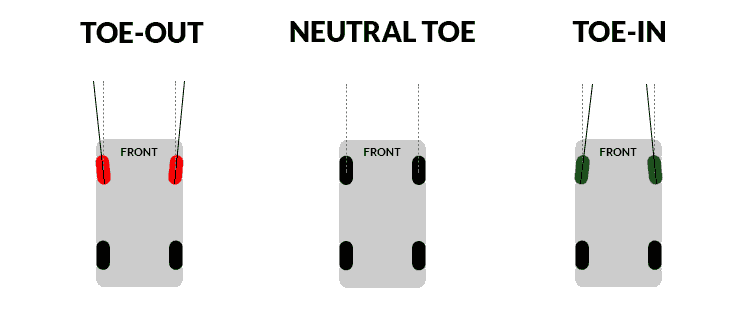
Toe is the measure of how far inward or outward the leading edge of the tire is facing, when viewed from the top. Toe is measured in degrees and is generally a fraction of a whole degree. It has a large effect on how the car reacts to steering inputs as well as on tire wear. Aggressive toe angle will cause the tire to develop feathering across its surface.
Toe-in is when the leading part of the tire is turned inwards towards the center of the car. This makes the tires want to push inward, which acts to improve straight line stability of the car as its traveling down the road, particularly at high speed (highway).
Toe-out is when the leading part of the tire is turned outwards away from the center of the car. This makes the tires want to separate from each other. This improves turn-in response considerably, but at the cost of tire wear. Running toe-out in the rear is generally not recommended since it will make the car want to pivot (oversteer) at all steering angles, but in the right setup it can help (auto-x / technical tracks) particularly if the rear toe bumps in.
We are constantly looking for new content ideas and feedback from the community. Head over to our contact page and send us an email with your ideas, comments, or questions.
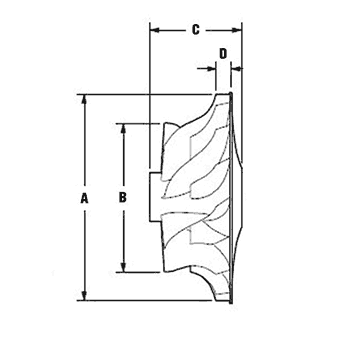
Join our email list to be notified when we release new content.
We respect your inbox and send only 1 - 4 emails per month.
We will never spam, sell, or do annoying things with it ... ever.